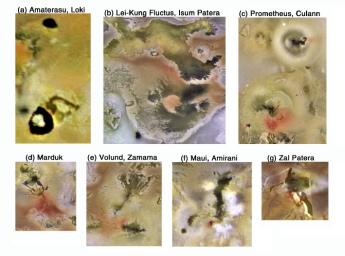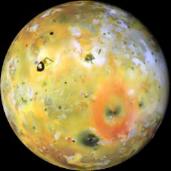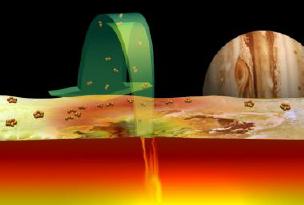Volcanism on Io
 Io
is the most volcanically active world in the solar system.
Most of its surface has been sculpted by volcanic processes
generated deep within its interior. Volcanic eruptions were
first observed by the Voyager spacecraft in 1979, and have
been witnessed in every flyby of the spacecraft Galileo,
which is currently exploring the Jovian system. Galileo
recently detected more than 100 erupting volcanoes, and
scientists speculate that there may be as many as 300. In
recent observations, some of the smaller, fainter volcanoes
appear to turn off and on, changing from hot and glowing to
cool and dim within a few weeks. Volcanic activity on Io is
so relentless that there are no signs of impact craters on
its surface, because they are rapidly filled in with
volcanic material soon after they appear. Given the volcanic
nature of Io, it is not surprising that place names on the
moon are taken from various mythological associations with
fire and volcanoes.
Io
is the most volcanically active world in the solar system.
Most of its surface has been sculpted by volcanic processes
generated deep within its interior. Volcanic eruptions were
first observed by the Voyager spacecraft in 1979, and have
been witnessed in every flyby of the spacecraft Galileo,
which is currently exploring the Jovian system. Galileo
recently detected more than 100 erupting volcanoes, and
scientists speculate that there may be as many as 300. In
recent observations, some of the smaller, fainter volcanoes
appear to turn off and on, changing from hot and glowing to
cool and dim within a few weeks. Volcanic activity on Io is
so relentless that there are no signs of impact craters on
its surface, because they are rapidly filled in with
volcanic material soon after they appear. Given the volcanic
nature of Io, it is not surprising that place names on the
moon are taken from various mythological associations with
fire and volcanoes.
 The
most distinctive features on Io are its volcanic calderas,
lava flows, and colorful deposits made by plume eruptions.
Io also has vast regions of volcanic flood plains. Sulfur
(S) and sulfur dioxide (SO2) are found everywhere
on Io, as evidenced by its surface coloration of yellow,
orange, red, and black. These colors represent the palette
of sulfur at varying temperatures. The patchwork of white
deposits is thought to be sulfur dioxide frost which has
condensed out on Io's cold surface.
The
most distinctive features on Io are its volcanic calderas,
lava flows, and colorful deposits made by plume eruptions.
Io also has vast regions of volcanic flood plains. Sulfur
(S) and sulfur dioxide (SO2) are found everywhere
on Io, as evidenced by its surface coloration of yellow,
orange, red, and black. These colors represent the palette
of sulfur at varying temperatures. The patchwork of white
deposits is thought to be sulfur dioxide frost which has
condensed out on Io's cold surface.
 New
information about the role of sulfur in Io's volcanism has
been obtained by combining results from Galileo and Hubble
Space Telescope observations. Sulfur gas (S2),
which is composed of pairs of sulfur atoms, was recently
detected above Io's volcano, Pele, by the Hubble Space
Telescope. This compound is stable at the very high
temperatures inside the volcano, but once it is ejected and
lands on the cold surface, the sulfur atoms rearrange
themselves into larger molecules of three or four atoms
(S3 and S4). These varieties of sulfur
are red in color, and they are the primary materials that
make up the red debris ring surrounding the Pele
plume.
New
information about the role of sulfur in Io's volcanism has
been obtained by combining results from Galileo and Hubble
Space Telescope observations. Sulfur gas (S2),
which is composed of pairs of sulfur atoms, was recently
detected above Io's volcano, Pele, by the Hubble Space
Telescope. This compound is stable at the very high
temperatures inside the volcano, but once it is ejected and
lands on the cold surface, the sulfur atoms rearrange
themselves into larger molecules of three or four atoms
(S3 and S4). These varieties of sulfur
are red in color, and they are the primary materials that
make up the red debris ring surrounding the Pele
plume.
The global extent of sulfur on Io caused considerable debate as to whether Io's volcanic features were produced by molten rock (silicate volcanism) or molten sulfur. The arguments favoring silicate volcanism were supported by the fact that the tall mountains and deep, steep-sided calderas on Io require a material of considerable strength to support them. The issue was finally resolved when Earth-based telescope detected temperatures at hot spots ranging from 1000 K to 1800 K. This is far too hot for sulfur to remain liquid, so silicate magma has to be involved in these high temperature eruptions. But that does not rule out the possibility that some of the lava flows on Io are composed primarily of sulfur. In fact, the distribution of sulfur on Io is still a subject of some debate. It may be that sulfur constitutes a relatively thin coating on Io's surface, or it could form relatively thick deposits in localized areas.
Photo Credits: NASA/JPL
Illustration Credit: NASA/JPL
